On March 6 we start our EcoTraining course
(www.ecotraining.co.za) at the Karongwe Game Reserve which is located in the Hoedspruit area, south-west of the Kruger National Park.
The reserve is about 10'000 hectares and is well stocked with wildlife.
During breakfast we meet the other students in the course:
2 Germans, Andreas and Christian.
This is great; practically a private course with 2 game drives or walks every day!
Having 4 German-speaking students turns out to be very practical, as we can help each other in translating German to English and the other way round.
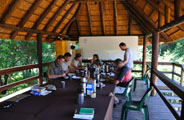

After breakfast we have the introduction into the camp and the daily routine.
5 AM: Waking up
5:30 AM: Coffee or tea with some biscuits
6 AM: Morning drive or walk
9:30 AM: Back in camp for a cooked breakfast
after 10 AM: 2 - 3 hour lesson, free time after that
3 PM: Lunch
4:30 PM: Afternoon drive or walk
8:30 PM: Dinner
Albie, our teacher, also wants to know what we expect and what we want because he will adjust the course to it.
He will try to cover as much of the material of the "Level 1 Learner's Manual" (that is usually taught in a 6-week course ....) as possible.
The rest of the staff, 2 young Dutch, Stephan and Joeri, John the Scot and Wilma and Lineth, the two local ladies from the kitchen are introduced as well.
During the intro session monkeys fool around in the trees and some unknown bird-songs can be heard .....
This is going to be tough but lots of fun!
We are shown the camps accommodation: some large tents under trees .....
(Note:
the whole camp is unfenced
.... )
We heard from Christian did he not really sleep too well during the first night in his tent, too many unknown noises!
Also Albie has a visitor every night that dives him nuts ....
So we decide to stay in the OKA.
It would be too much hassle to move into a tent ..... and it would also mean no fridge, no toilet at night ..... boy, are we spoiled!
So we get organised.
While Ruedi slashes all the grass around the OKA so no ants will move in Susi starts putting staff away that has still been lying around from when we unpacked our backpacks.
As the monkeys still fool around in the trees we are warned not to have any unwrapped fruit in the camper as the monkeys will move into the camper and get it.
For the same reason we are also advised that we should not leave the windows or roof hatches wide open .... ok, thanks for the tip!
After lunch we get ready for the afternoon drive.
Stephan and Joeri join us, Albie is the driver.
First Stephan is the "spotter", he gets the front spotter-seat on the bonnet of the vehicle.
Soon he starts pointing out animals ...
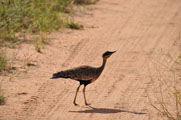
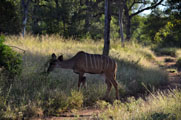
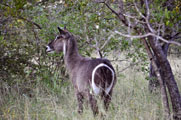
For the ones interested in the names of the animals just place the mouse over the picture and where available / found in the books it will be displayed.
Should a name be wrong please let us know, thanks.
Albie, John, Stephan, Joeri, Christian and Andreas: Your comments please!
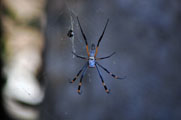
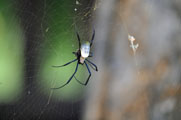
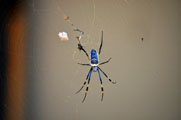
The spiders are abundant and especially the Golden Orb-Web ones are huge.
During the night and early in the morning the one in the spotter seat does not really appreciate them .....
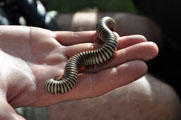
Very pretty Millipedes can be found and also touched.
Each segment has 4 legs, two on each side ..... quite some tickling on
your hand when you handle them!
Just don't try the same with a Centipedes as they have a nasty bite!
Should you not remember which ones bite and which ones don't:
Just try both and you will remember it for ever ....
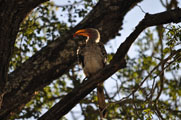
The Hornbills don't really look pretty but they often come in groups and are an amusing lot to watch.
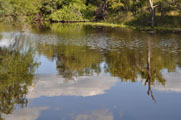
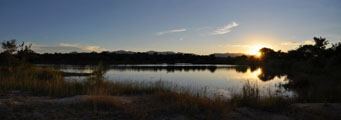
Albie checks out one dam after the other for animals .... and at one of them we stop for a sun-downer drink to enjoy the sunset and the atmosphere.
On the way back to the camp Joeri takes up the spotter-seat and also the spot light.
He has to shine into the bush and look for the reflection of eyes.
As we pass a dam Joeri points out a White Rhinoceros or Square-lipped Rhinoceros we just passed.
It is a rather well-nourished male.
We stop and watch it.
The Rhino does not really like this and slowly starts approaching the back of the vehicle.
Albie does not react and we get a bit nervous as the Rhino gets closers and closer.
Especially Stephan, who sits on the last row of seats gets a bit uneasy with the distance between him and the large horn
diminishing quickly .....
Then Albie starts the vehicle and drives forward a bit ..... but there we see 2 more Rhinos, the females!
Now we understand why the male does not like us being here.
We are between it and the females!!!!
As the male still follows us we drive off and leave the area.
We learn that it is important not to flee the scene, but moving off slowly.
One should show respect but not fear, as the animals would learn from this.
Unfortunately it was to too dark for good photos.
What a sighting!
Definitely a 5 out of 5!!!!
As we drive back south Joeri suddenly signals Albie to stop the vehicle and carefully shines the spot light into the grass.
The black-and-white striped heads of two Honey Badgers can be seen just before they run away and disappear in the grass.
"How lucky is that?" says Albie.
Apparently it is very rare to see Honey Badgers ... and then two of them!
We feel great!
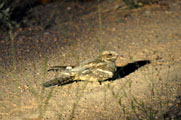
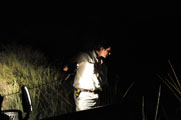
As we drive on there are birds on the road.
They are Nightjars who take the advantage of the warm track to soak up some heat before it gets cooler.
They always stay on the track until the last second before they fly off.
Albie also stops at one other dam, where the frogs are giving a delightful concert.
Click here for a bit of it.
We head back to the camp for dinner.
The ladies have cooked up a storm and the food is great.
We will have to watch out that we don't put on (too much) weight.
What a day!

On Monday morning we have a walk.
First we are instructed on how we must behave as group in the bush.
As Susi has the shortest legs she must walk directly behind Albie, then the rest in single line with John at the end.
Reason for that is that the predators are on their way home and should we get attacked by a wild animal Albie with the gun must have a free line of fire.
Also we are asked to keep the noise to a minimum and not speak with each other.
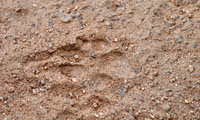
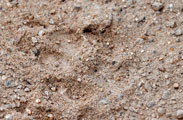
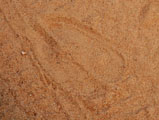
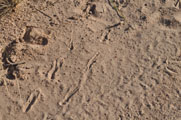
Albie teaches us about tracks.
He tells us what is important when looking at a track so we can not only find out what animal track we are looking at but also in which direction the animal has gone and also to estimate if the track is fresh or not.
It reminds us a bit of reading the newspaper .....
who has come past since we last drove through here?
As we walk we stop at a termite mound and hear about the different termites, what they eat and how they grow their fungi, as well as the other animals that live in the same mound like spiders, snakes .....
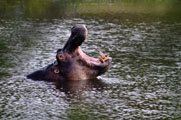

At one of the dams close to the camp we can watch some hippos.
They stay in the water all day but after the sun sets they will wander around to feed.
Occasionally they also come up to the camp - so watch out at night!
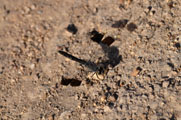

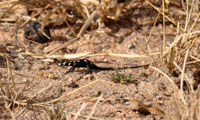
There is also a lot of small stuff to be looked at.
Back in camp the great breakfast is enjoyed with a well-deserved hunger.
Today is no-meat Monday (EcoTours have one day per week where they don't serve meat as their part towards conservation of the environment).
The ladies have cooked an omelette, there is yoghurt and cereals, fruit-salad, toast, jams and spreads etc. etc. and nobody has to starve!
The camp is known for its kitchen and many of the previous students have put on weight .... no wonder .....
After breakfast it is class time.
Albie jokes that it will not be long before the first one gives up and falls asleep.
But with Christian being a hunter, Andreas being involved in animal conservation and us two with 4 years of Australian nature "experience", between the four of us we bring a lot of knowledge along. Albie's teachings fill the gaps and there are
many questions, many "aha" and "hmmmmm".... and so much to be learned.
Note: There might have been the odd yawn but during the whole 2 weeks none of us fell asleep ...
In the afternoon we head out for a game drive again.

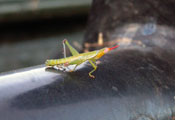
We stop for sun-downers at the "Rhino"-dam .... but nothing is happening.
So we continue on.
Albie hears on the radio that the lions have been spotted further north and asks if we want to go there.
What a question!
When we arrive we search but have no success.
Then we see lights coming towards us and cross the vehicle from another lodge.
After a bit of a chat they pass us, stop just a few
meters behind us and drive into the grass.
What is happening?
Then we hear it on the radio ... we had just driven past a lion!
We were so concentrated on the oncoming vehicle that we missed it.
Quickly we turn around and head back to the spot.
Soon we are allowed closer and get a good look at the large male lion, laying about 5 meters away in the grass having its siesta.
As it is not moving we decide to leave it and come back later hoping that it is awake then.
It gets dark and Albie reckons it is time to go back to the lion.
The lion has woken up and is walking along the road roaring every so often.
There is already a vehicle following the lion so we have to wait.
As the lion and the vehicle are coming toward us we have to reverse and hear a roar from the side .... an answer to the lion on the road.
Albie reacts quickly, turns the vehicle and heads over to the dam.
He expects the large lion to head over to the dam and meet with one or both if his sons.
When we come to the dam there is a male lion laying on it.
It is not bothered at all by the spotter light and we get a great view of it.
We sit in the vehicle and take pictures
like crazy.
What a sight!
We can see another vehicle approaching from the road and Albie explains that this is the vehicle that tracks the old lion.
Every so often one lion roars and the other one replies.
Our vehicle is standing beside a bush and suddenly there is a roar right from behind the bush.
We almost get a heart attack when another large lion walks past the vehicle just a few meters away from us.
Albie orders us NOT to stand up
so we blend in with the vehicle; that way we are safe.
As soon as we would stand up the lions would realise that we are not part of the vehicle and especially at night this could get dangerous.
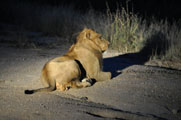
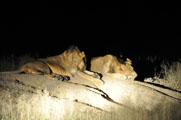
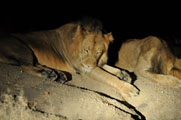
The young lion that was lying on the dam gets up to and together with its brother trots towards the old lion that has now reached the dam too.
We sit and watch and listen and just cannot believe our luck.
Then it is time to leave so other vehicles get a chance to see this great set-up as well.
We would have loved to stay a bit longer but we had been so lucky and had had the young one just for us, so we reluctantly leave.
On the way back to the camp Joeri is in the spotter-seat again.
And is he lucky again!
As we drive along the fence he spots a Cape Porcupine that is fanning its black-and-white quills.
And as we drive on he spots another one on the other side of the road!!!
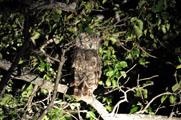
Then he spots some owls, one even lets us take pictures of itself.
This is crazy!
They are wild animals, this is not a zoo!
We are all excited when we come back to the camp and Albie reckons that we are one lucky group!
On Tuesday, March 8, we go for a morning drive.
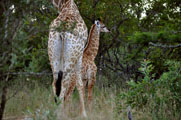
A mama giraffe allows us to have a good look at her baby.
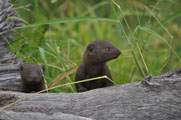
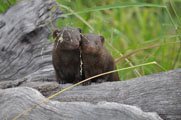
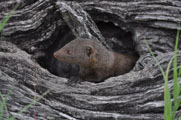
Then we find a log with a Dwarf Mongoose family in it.
They are so cute!
Click here  to view the movie. to view the movie.
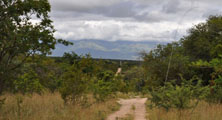
The weather is not too good but is also makes is a bit less hot.
As we drive through a bit of thicker bush we suddenly surprise a Leopard walking on the road.
It quietly disappears in the bush on the side of the road .... we can just see the spots reflecting in some sunshine .... and then it is gone .....
Albie tells us that it is quite unusual to spot a Leopard ... and that John has not yet seen a Leopard ... and he has been in Africa since September 2010!
This is not surprising.
If you look at the landscape you will notice that large areas in this park are not open savannah but quite dense bush.
It is very difficult to spot animals even if they are sometimes just a few metres in the bush.
How lucky are we!
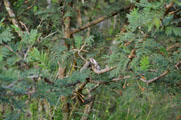
As we continue on suddenly Albie stops the Defender, reverses a bit and asks us if we can spot the animal in the tree.
Animal .....?
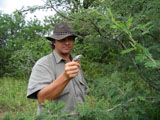
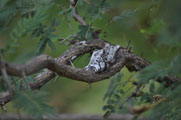
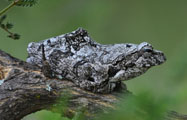
It is a Grey Tree Frog.
What an amazing camouflage it has!
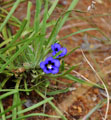
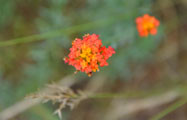
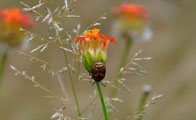
Today we also stop for a macro-session ....

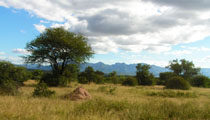
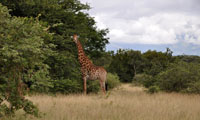
Karongwe has many different sections, one of them is a dryer savannah where the Giraffes like browsing the trees.
This is how Susi has in visioned Africa!
Just the sunset is missing for her perfect picture ..... thank God, otherwise we would have no more reason to stay here a bit longer!
Back in the camp we tell John and the boys about the Leopard.
John gets even by telling us that while Joeri had been painting the deck of one of the houses a Cheetah had walked through the camp ..... they had all gathered on the deck and got a good look at the Cheetah.
Ok, 1:1!
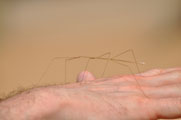
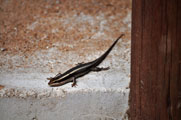
In the camp we find some more interesting creatures: a Stick Insect, a Striped Skink ....
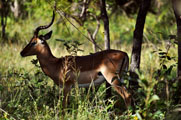
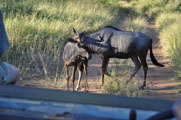
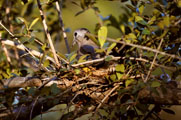
During the afternoon drive we get some good views of Impala, Wildebeest (or Gnu as we know it from the zoo), a pigeon sitting on its eggs ..... etc. etc.
Albie keeps pointing out animals, but if we cannot take pictures of them we just don't remember all we have seen!
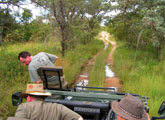
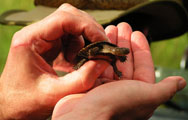
In a section with some water Christian, who is now our spotter, gives the stop-signal and we wonder what he has spotted.
A
Marsh Terrapin!
We would have driven right over it!
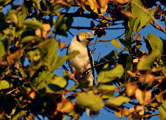
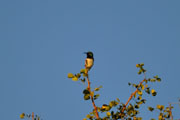
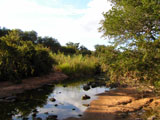
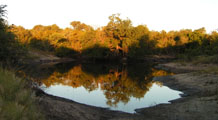
The afternoon is a bit of a bird-drive with many new names that we will not be able to remember .....
On Wednesday we go for another walk.

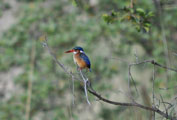
It is a good way to see the insects and smaller birds like the Malachite Kingfisher
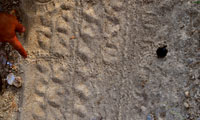
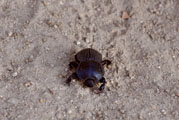
We spot a Dung Beetle and can watch his tracks.
Albie tells us about its "way of life" and promises to point them out when they are in action ... ok ....
A bit further down the track we see a group of ants.
Albie explains that these are Matabele Ants (Ponerine Ants) that raid termite mounts in military-like columns a few centimetres wide and several meters long.
Click here  to view the movie. to view the movie.
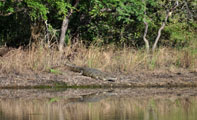

At the dam the Nile Crocodile has already left the water and is taking in some warmth from the sun.
As we watch it opens the snout to regulate his body temperature .... it is a rather large specimen and we don't really fancy going for swim in the dam .....
The afternoon drive comes to an abrupt stop when Albie spots a fresh mount of Rhino dung ... still warm and no dung Beetles on it yet ....
He checks out in which directions the Rhino has gone, orders us to stay in the vehicle, grabs his rifle, checks the wind direction by letting a bit of sand run through his finger and starts following the tracks into the bush.
A few minutes later he shows up again and asks us if we fell like sneaking up to a White Rhino?
Hmmmmmm .... why not?
Albie reminds us of his instructions on how to behave and wants us to follow them EXACTLY.
The most important and most difficult to achieve would be:
What ever happens NEVER ever run and always stay together as a group.
HE would tell us if it is time to run.
A running subject triggers the hunting instinct of an animal and the one leaving the group would be the target.
And he asks us to walk quietly and to watch where we place our feet so we don't step on twigs generating more noise than necessary.
And no talking and no clicking of cameras!!!
We get into the thicket and maybe after some 30 meters already can spot the Rhinos feeding.
They seem relaxed and have either not smelled us yet or do not consider us to be too close to become dangerous to them.
Albie orders us to get down and sit still.
We are now allowed to carefully take some pictures but it is not a good view so we just
sit and watch the Rhinos for a bit.
Then Albie whispers if we are brave enough to get a bit closer.
When we all agree he instructs us to try to walk even quieter and gets moving.
The group follows quickly.
We get into a gully from where we have a good view
and settle down.
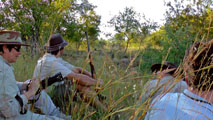
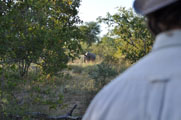
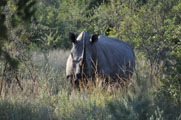
The Rhinos stop eating and watch us.
We must have reached the recognition zone.
Albie gives us instructions that should one of the Rhinos start coming towards us fast we must get into a tree immediately.
When the Rhinos relax a bit Albie asks us if we are fine with the idea of him getting up and checking out how the Rhinos react ..... yes sir!
As the Rhinos don't seem to be really bothered we are also allowed to get up and get a great view of the Rhinos.
A few hundred pictures later we are instructed to get into the gully and make our way to the vehicle slowly.
Back in the safety of the vehicle we are all very excited.
We must admit it was a bit close for our own comfort, but we trust Albie's experience.
(He has some 15 years of experience with wildlife, is an instructor for all 3 levels of field guide trainings and is also an assessor for all levels.)
We decide that this must have been a 10 out of 5!!!!
What an experience!
As we drive along Albie hears on the radio that the Cheetahs have been sighted.
Quickly he drives in that direction and we line up to view them.
As the sun is already very low it will be a race against darkness ....
Then the last group of tourists is lead out of the bush and it is our turn.
The guide walks very quickly and we have to speed up to follow.
Some 200 meters into the bush suddenly we are in front of the Cheetahs.

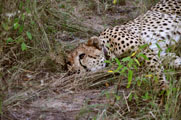
Because they are used to humans we can get close to them but are instructed not to scare or even try to touch them as they are still wild animals.
On the way back we chat and Albie says that we must be one of the luckiest groups of students he ever had:
In 4 days besides we have already seen Rhinos, Hippos, Lions, a Leopard, Cheetahs ...
Then he asks what we have missed so far.
The answer comes quick: A Warthog!
Even though Albie, John, Stephan and Joeri assure us that the population of Warthogs is quite large in Karongwe we have not seen one single Warthog so far!
So we put the Warthog on the top of the wish-list for tomorrow.
On Thursday the morning drive takes us down to the dam for a macro session.
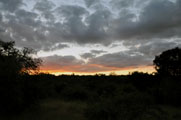
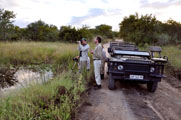
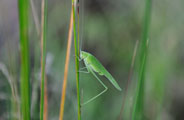
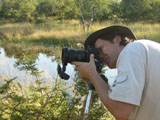
Soon we are all busy either taking pictures or spotting animals for the photographers.
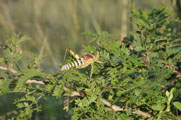
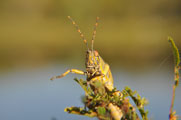
This Elegant Grasshopper is just too pretty!
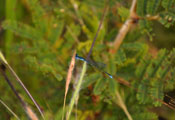
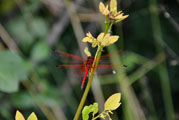
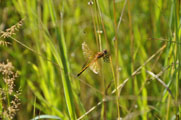
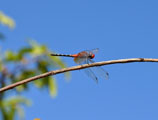
There is also a fine selection of dragonflies ....
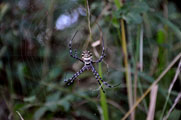
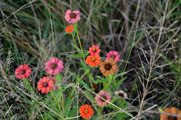
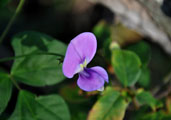
... a Banded Garden Spider....... and some flowers.
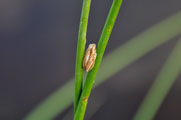
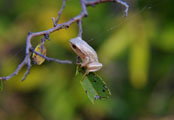
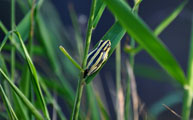
After having heard its song the other night we get a good look at the Painted Reed Frog.
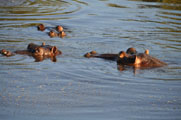
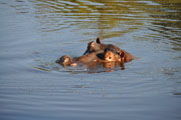
At the "Hippo-dam" the Hippos are in a playful mood.
Click here  to view the movie. to view the movie.
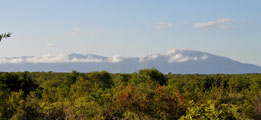
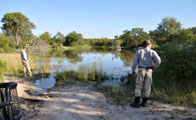
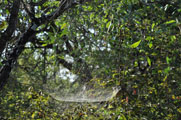
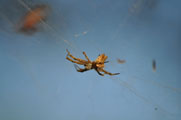
Today it looks like it will be a pretty (and hot) day.
We stop at a dam for morning drinks and can have a closer look at a Tropical Tent-web Spider and its interesting web.
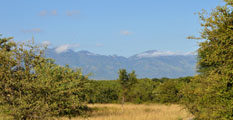
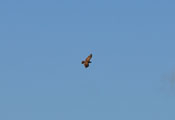
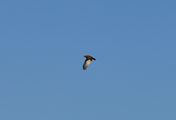
As we head north again we can watch a Brown Snake-Eagle.
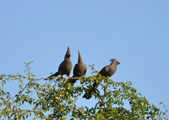
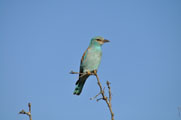
The Grey Go-away-birds and the European Roller are now recognised by us.
We even recognise the song of the
Go-away-bird because it makes this "g'way" sound ....
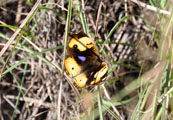
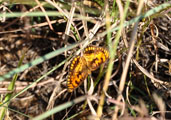
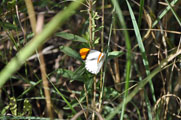
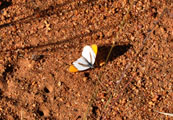
At another macro session we have time for butterflies: Yellow Pansy, Spotted Joker and Common Orange Tip ....
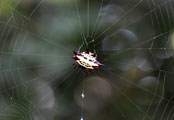
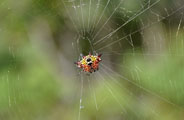
... the pretty coloured Yellow-and-black Kite Spider ....
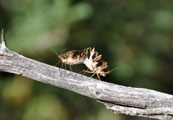
... some Broad-headed bugs that are mating ......
They did not feel disturbed at all ... not even when Albie placed them on another branch so they were in better light!!!
In the afternoon we check out the various dams but there is not much happening today.
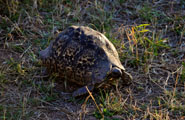
All we come past is a Leopard Tortoise.
It almost looks like today could be a quiet day .....
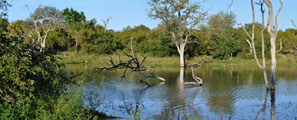
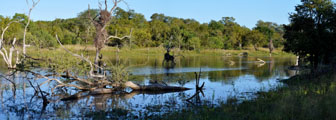
We stop at the dam where we saw the lions the other day.
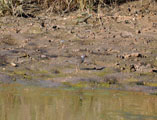

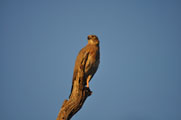
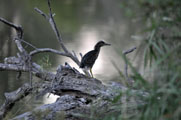
The birds are present: Three-banded Plover, Woodland Kingfisher, Brown Snake-Eagle and probably a juvenile Green-Backed Heron but no other animals come for a drink.
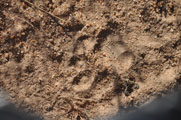
We drive to the other side of the dam to have a look for tracks and we actually find some fresh ones!
Tension is rising ......
We get back into the Defender and Albie drives to the fence near the place we saw our first lion some days ago.
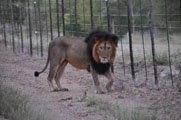

As we come round the corner we almost bump into the large male lion!
It is standing at the fence that separates Karongwe Game Reserve from the neighbouring Game Reserve and is marking his territory with loud roaring.
The distance to the lion is below 10 m.
Click here  to view the movie. to view the movie.
Andreas sits in the spotter-seat.
The lion slowly starts walking towards the front of the vehicle .... and Andreas ....... and then lies down and waits.
Albie tells Andreas not to move as for the lion he is "part" of the vehicle.
Then Albie slowly reverses back to the intersection and takes the track that leads in direction of the camp.
But we don't get far ......
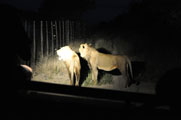
Our way is blocked by the two young lions!
They are walking along the track leaving territorial marks on the bushes.
They don't feel like leaving the track at all and we have no other choice but to slowly follow then by driving a few meters behind them.
When we come to the next intersection the lions turn into the same direction we have to drive .....
Hmmmmm ..... this way we will not get to the camp on time!
Albie starts turning the vehicle around to take another route when the lions decide to leave the track and head into the bush .... but not before leaving one last marking on the side of the track ....
What a sighting!!!
Another 10 out of 5!!!
But still no Warthog ....
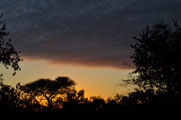
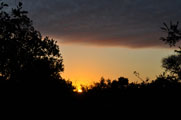
On Friday, March 11, we want to walk to Beacon Rock.
John will meet us there with the vehicle and morning tea.
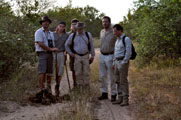

On the way we come past some fresh Rhino dung.
We will check it out on the way back to see if the Dung Beetles have already started their work ....
John already waits for us and we enjoy a nice cup of tea and some biscuits.
Before leaving Beacon Rock we all get to the look-out.

It is a bit hazy ....

.... we could get a bit of rain soon .....

.... the Drakensberge seem to already get some ....
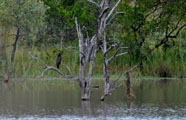
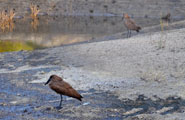
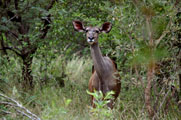
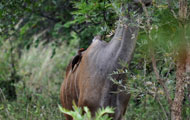
At the dam we can spot an African Darter and a Hamerkop.
A Black-backed Jackal comes for a drink but disappears again before we can get a proper picture of it.
Later on a Greater Kudu with a Red-billed Oxpecker on his back stands still long enough .....
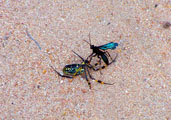
Back in camp Albie call us to have a look at a Spider-Wasp.
The wasp paralyses the spiders and then inserts its egg into the spider.
The spider will stay alive until the young of the wasp hatch and will then serve as fresh food .... what a great feeling .....
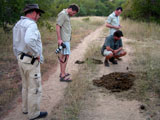
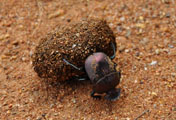
In the afternoon we head to the Rhino dung and find the Dung Beetle active.
They are very funny creatures and we could have watched them for ever.
Click here  to view the movie. to view the movie.
Today is a special day.
We wanted to have a sleep out in the bush.
It would be a great experience for all of us as we would have to guard the camp in shifts the whole night long.
Unfortunately Albie does not get the ok from the camps management so he offers that we eat out at one of the dams.
So around dinner time we drive back to the camp and pick up the food and all gear.
We had already picked a site in the afternoon so we don't not have to search for a good spot.
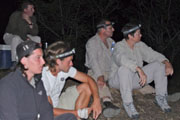
After getting organised we have sun-downers, look at the stars and search for satellites.
Dinner is served in style with fish, baked potatoes, vegetables ... all in proper china, not cardboard plates .....
Then we return the gear to the camp, pick up our jackets and go out for a night drive.
Joeri is in the spotter-seat again ..... let's see what he finds for us today!
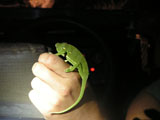
Albie spots a Chameleon.
We wonder how he does it.
He shows us that a
Chameleon, even though it is green and sits amongst green leaves, stands out because of the different very bright green.
It kind of reflects the light differently to the leaves.
Then Joeri spots a Bush-Baby, his favourite animal.
They are cute with the large eyes.
Later on he gives the stop signal and points to a tree.
A
Small-spotted Genet sits in the branch and looks down to us.
Sadly there are too many branches and the camera cannot focus on it.
Next exciting animal is an
African Wild Cat.
We are too excited (and noisy ....) so it quickly disappears into the bush .....
Again we have been very lucky and have seen a lot of animals that one usually does not see ... but again no Warthog!
We start giving Albie a bit of a hard time, doubting that there are any Warthogs in Karongwe ......
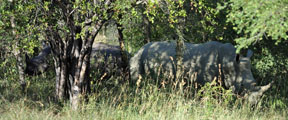
During Saturday's morning drive we find this White Rhino mama with its young peacefully grazing close to the track.
Albie reckons that mama is pregnant.
As the young one is approx. 2 years old it will be pushed away by the mama and will have to find its own way soon ....
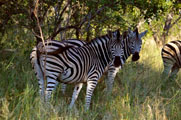
Today is another special day.
Even the normally very shy
Zebras today give us the chance of a good sighting.
Albie calls them ... and they even come!
He is just amazing!
Click here  to view the movie. to view the movie.
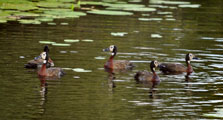
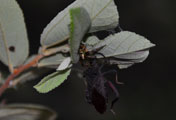
At one of our regularly visited dams the White-faced Duck family is present with their young ones.
A second family with approx. 10 young ones that are probably just a few days old quickly ushers the young ones under some branches that are hanging over the water ......
A spider that has caught a beetle that is many times its own size is found too.
When we get together after breakfast for the lesson somebody has written on the white board: "Where is the Warthog?"
Albie wonders too .....
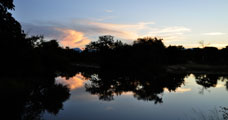
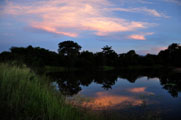
The afternoon drive is not very spectacular, but the sunset is!
Today it is Ruedi who is in the spotter-seat.
We drive around and spot the one or the other animal.
Then Ruedi gives a desperate stop signal ....
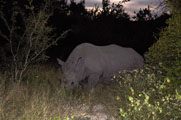
.... and we stand right beside a White Rhino!
Ruedi feels very uncomfortable, so close to such a huge male.
The Rhino
inspects us and then decides that we are no threat and continues eating ... and we get a great sighting.
This is definitely another 5 out of 5!
But still .... no Warthog!!!
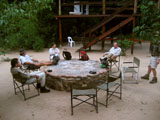
On Sunday morning, as we have our cup of tea, a Spotted Hyena sneaks through the camp.
We jump up to get pictures but the Hyena disappears .....
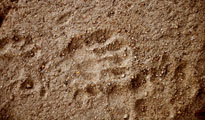
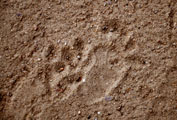
As we set out for our walk we can see fresh Baboon tracks.
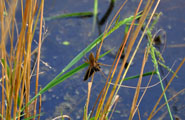
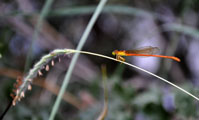
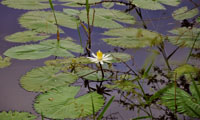
Down at the dam there are no Hippos today but we get time for a macro session again.
A Grass Huntsman Spider has caught a large insect, amazing that they can hold on to such a weight!
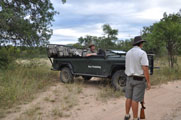

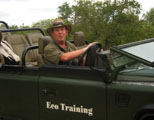
As the group feels like a bit of exercising John is instructed to take the vehicle exactly 2 km and wait for us.
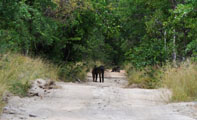
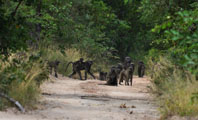
As we walk suddenly the Baboons appear, first a male checks out the situation and then the rest of the mob follows.
They are close to the camp so we might have a chance to see them down at the river later on.
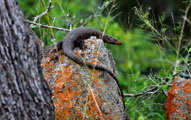

It gets hot and a Giant Plated Lizard is spotted.
As we watch it through the binoculars we spot two Five-lined or Rainbow Skinks on the tree just in front of the rock, where the lizard sits.
Again we are amazed on how little we see when we look ... if one REALLY has a close look there is so much more to be seen!
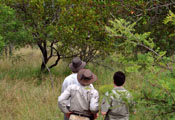
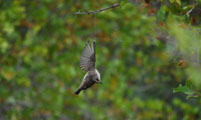
We spot something special: a bird that got caught in a spider web!
As the light is not good we decide to come back later on for a picture session.
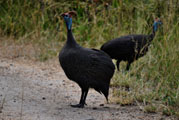
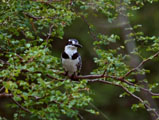
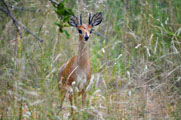
Some more animals cross our way .... Helmeted Guinea fowl (they are good fun to watch, when they run ahead of the vehicle .... looks like they don't have much brain in their head ....), Pied Kingfisher and a pretty Steenbock.
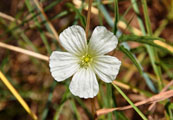
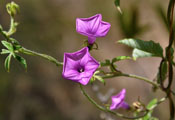
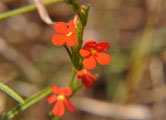
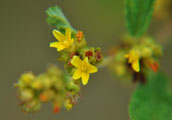
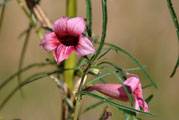
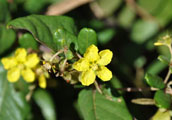
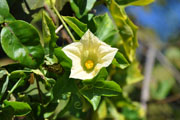
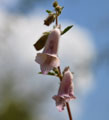
Susi find a spot with flowers .....
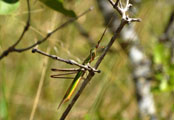
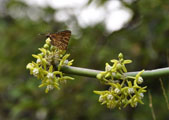
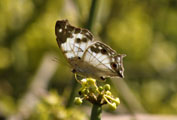
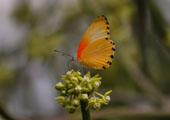
.... back in the camp the insects ...
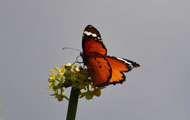
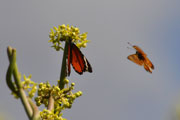
... and a group of Common Diadem butterflies keep her busy too ...
We head down to the river to check for tracks and to see if the Baboons have come past yet.
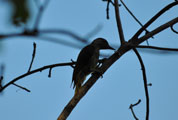
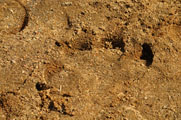
We find a Woodpecker ...... and some Hippo tracks.
Ahhhhhh ... so that's was what we heard last night!
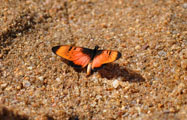
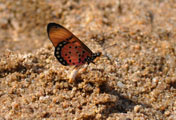

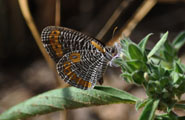
Some butterflies and dragonflies come for a drink ....

The afternoon has the perfect light ....
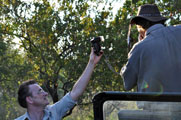

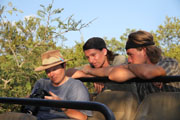
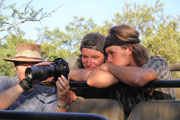

... and we pay a visit to the bird.
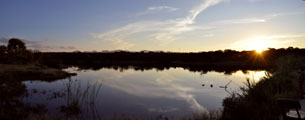
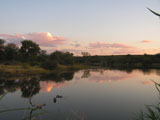
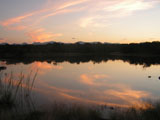
We stop at the "lion"-dam for sun-downers but don't hear any lions.
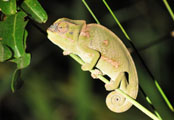
On the way back to the camp we spot another Chameleon.
This time even we students see it!
On Monday morning, while we have the morning coffee the Spotted Hyena comes into the camp again.
We watch it checking out the bins, but as there are only empty can in them the Hyena does not show any interest.
Then it sneaks closer to the kitchen .....
Too late John realizes that the bin with last night's food scraps had not been taken into the kitchen last night.
He jumps up and tries to shush the Hyena away but without success.
With amazement we watch it take the bin and with ease and carry it away.
The Hyena is a female and is so large, that it can carry the bin in its snout without having to stretch its neck .....
Wow!
What a sighting, definitely a 5 out of 5 again ..... and nobody had a picture taken!
We were too busy watching and too surprised!
None of us had thought Hyena to be so bold to come so close and pinch a bin!
Stephan and Joeri chase the Hyena to retrieve the bin but only come back with its lid.
The Hyena has carried the bin into the grass and they will check for it later on, when there is a bit more light.
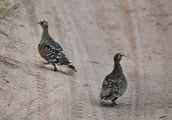
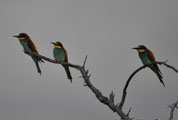
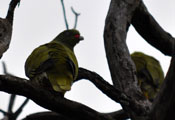
We head out for our morning drive and after this excitement don't mind that we "just" see a lot of birds.
We stop at the dam and as we walk around checking for wildlife suddenly a Nile or Water Monitor tries to flee, misses the next branch, falls out of tree and into the dam with a loud splash right in front of us.
Then we head north to the river.
The Cheetahs have been sighted there and we want to see them in good light.
As we drive along the track suddenly this large Leopard crosses the track and disappears into the bush.
Albie reckons it must be the largest male Leopard he has ever seen, about 60 kg of weight.
He grabs his gun, orders us NOT to leave the vehicle and checks the bush for the Leopard.
But even though the other animals are still calling out warning calls and we drive up and down the track a few times we cannot spot the Leopard anymore.
Wow!
Two Leopard sightings in less than two weeks .... and again John is not here with us!
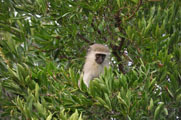
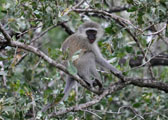

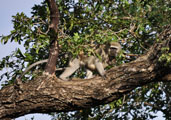
We stop beside a tree full of Vervet Monkeys and have a great time watching them fooling around.
Click here  to view the movie. to view the movie.
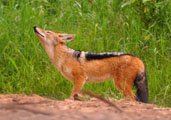
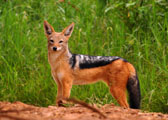
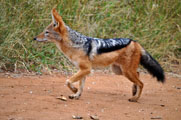
We cross the river and suddenly find ourselves at an intersection that is being patrolled by a pair of Black-backed Jackals.
They don't care about us at all and continue on with their routine, a great chance for us to watch them.
Click here  to view the movie. to view the movie.

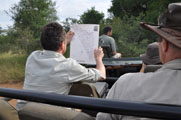
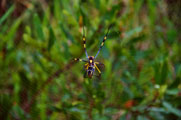
At the turning point of the track we have a break and find a Banded-Legged Golden Orb-Web Spider weaving its web ....
Click here  to view the movie. to view the movie.
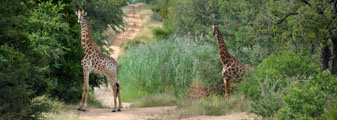

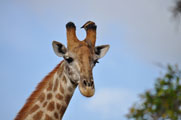
On the way back to the camp we come past this group of Giraffes, one even has an Oxpecker picking ticks of its horns!
Click here  to view the movie. to view the movie.
The weather has been deteriorating all day and storm clouds are building.
Albie reckons that we will not get wet and gets the vehicle ready for an afternoon drive.
Just to be on the safe side Ruedi packs our plastic raincoats ... one never knows .....
We get approx. half the way to the river when the first drops falls.
Hmm .... what now?
We continue on a bit more but then we see the rain closing in and turn around.
Christian has also brought his rain jacket, Ruedi puts his raincoat on and Andreas and Susi use Susi's raincoat as roof and to protect the cameras.
The only one that has no gear is Albie ....
It becomes a race against
the rain.
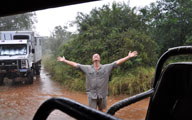
More and more rain falls and just as we reach the camp the heavens open.
We are more or less dry but Albie is soaked!
Serves him right for misjudging the weather like that.
No wonder he did not touch that topic in the course :-)) !
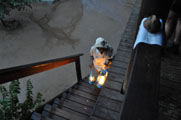
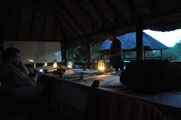
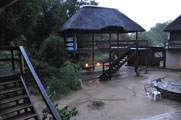
The rain stays for a while and the ladies have to bring the lamps earlier than usual ..... but it also cools down nicely.
After dinner we discuss what we want to do regarding an early morning drive.
On the one side it is great to go out right after the rains because all the frogs and
animals that like it wet are out.
This means that also their predators will be out so we could see different wildlife .....
So we deice that:
- if it rains we sleep in and have a double lesson starting at 7 AM
- if it drizzles Stephan, who is the coffee / tea person tomorrow will have to check with Albie and he will decide if we head out or not
It rains for most of the night but at 5 AM Stephan comes round and makes sure we are up and get ready for a drive.
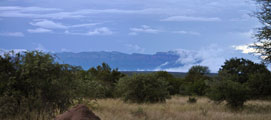

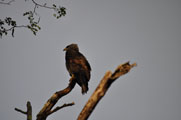
The clouds are still hanging around and water drops from the trees but it looks like we will get a fine day.
A
Wahlberg's Eagle patiently endures the photo session ....
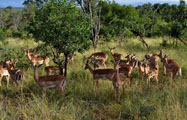
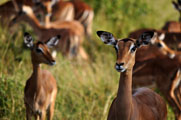
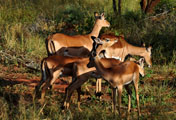
We see many animals on our way up to the river.
Especially one group of at least 60 - 70 Impalas let us come very close and finally graze around our vehicle.
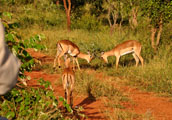
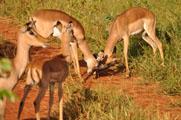
Two bucks have a bit of a fight ....
Click here  to view the movie. to view the movie.

When we reach the river it has too much water so we turn around and head back to visit the various dams and check for animals.
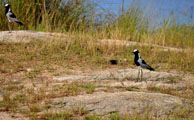
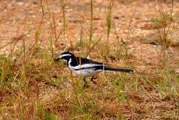
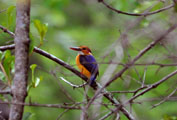
The birds sure are out in force .... Blacksmith Lapwing, African Pied Wagtail, the pretty African Pygmy-Kingfisher .....
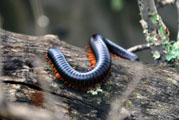
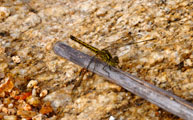
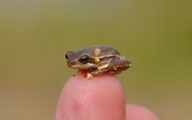
... and also the insects are busy ... Millipedes, dragonflies, a tiny Painted Reed Frog ...
Especially the Millipedes is fascinating .... how it moves its legs .....
Click here  to view the movie. to view the movie.


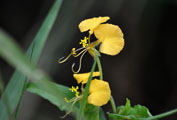
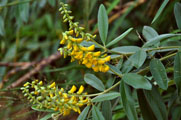
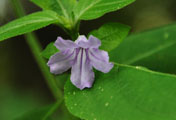
Susi's flowers ......

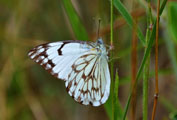
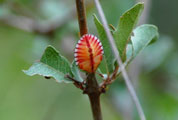
... and some more insects .....
It is hot and humid and we are glad to be back in the camp.
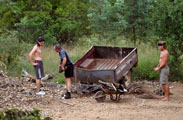

When we walk to the OKA we see Joeri and Stephan cutting wood for tonight's braai.
The wood is incredible hard and they have no proper equipment.
Ruedi feels sorry for them, unpacks the chain saw and shortly after all is done.
The boys don't mind at all ....
Albie has arranged with the GVI team (the ones that monitor the animals in the reserve) that we can join them and go to spot the Cheetah before they pass the position to the other resorts in the 4 PM update.
In the Karongwe Game Reserve some Lions and Cheetahs have transmitters that allows them to be tracked in the bush ... it does not mean that they can be seen, we just know in which segment they are.
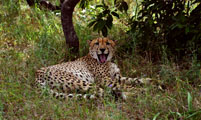
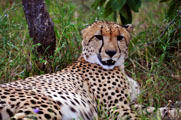
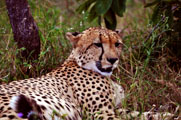
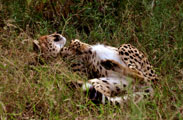
We are very lucky and the Cheetahs are very close to the road and easy accessible.
Today they are not as lazy as last time and we get some great views.
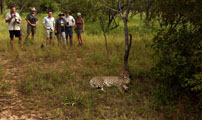
Even a group picture with the Cheetah is possible .....
Beth from the GVI team comes with us for a ride.
She asks us what we have seen so far and is impressed about the great variety of animals and the frequency if the sightings.
When she hears that we have been on game drives for ten days now and have not yet seen a Warthog she promises that she will spot one for us.
And sure enough, as soon as we leave the Cheetahs
she spots a Warthog running away .....
Now the spell is broken!
Ruedi spots two more but in both cases they run away and we only get a glimpse of them and their follow-up sign: their upright tail when they run.
Ten days without a Warthog ... that will probably be a record for Albie that is hard to be surpassed!
When we drop Beth at her camp she gives us instructions to other animal sightings and we are on our way.
Suddenly we have a "road-block" again .....
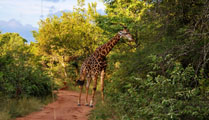
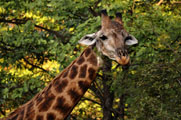
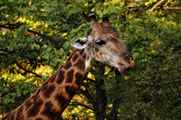
... this massive male Giraffe is not impressed by the vehicle and just continues on eating.
They love that prickly acacia bush ... and if they have too many thorns in their tongue they just sort of peel it .....
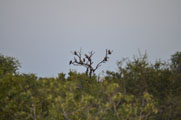
Then we reach the Vultures that Beth had told us about, but they are too far away.
But we take their position and will track them tomorrow morning.
They will not move away as long there is any meat left on the kill .....
A big Giraffe has died or has been killed nearby in the thicket but we are not allowed to walk to the place.
There are too many predators in the area.
It would have been too dangerous.
On Wednesday, March 16, we leave a bit earlier in the morning as we want to drive up to the river and check the vultures before it gets too hot.

First stop is at the "lion"-dam but there is "only" ......
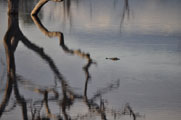
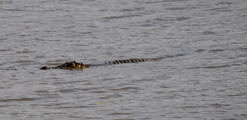
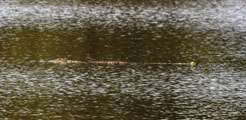
... a large Nile Crocodile displaying its back.
We check some tracks and get really close to the vultures.
There are at last three trees full of them
but the light is not good for pictures yet so we decide to come back later.
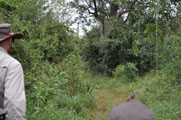

Ruedi is
the spotter-seat again and gets the full pleasure of the spider webs still hanging over the track.
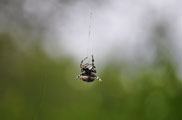
By now we are used to Orb Spiders but he would definitely not have liked this large Bark Spider ....
On the afternoon drive we head back up north to the river.

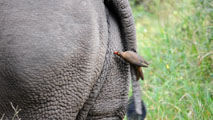
We spot this large male Rhino right beside the side of the track and we can get REALLY close ...
We are so close that we can hear the Rhino grazing and
we can even see the Oxpecker pecking the ticks off the Rhinos tail.
How good is that?
5 out of 5 is not good enough for such a sighting!
Click here  to view the movie. to view the movie.
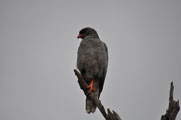
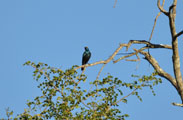
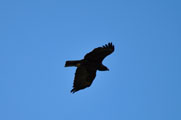
A Dark Chanting Goshawk, a Forktail Drongo and a Wahlberg's Eagle happen to fly past the camera .....
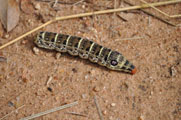
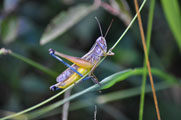
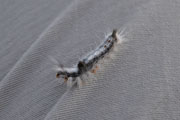
..... and some macro pictures as well ....
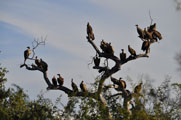
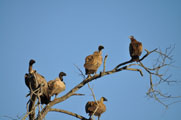
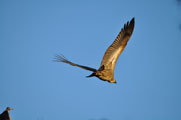
Then we are back at the trees with the vultures.
There are
White-backed Vulture and Cape Vultures.
Absolutely ugly birds .... but fascinating!
And the sound of their wings when they take off ..... they are heavy!
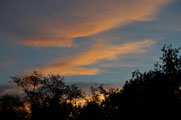
Another pretty sunset in Africa .....
Thursday it is our last day of game drives.
We get up a bit earlier as we want to head up to the river again and see if we are lucky.
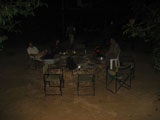
But first we get into position to watch the Hyena on its morning tour.
Susi and Andreas are on the top deck with all cameras in place and Ruedi and Christian are waiting with some flash lights.
And we wait ..... and wait ..... and wait .... and it does not come .....
Well, they are wild animals after all, aren't they?
So we hit the road .....
Today the animals are very relaxed .... or they feel that we are relaxed!
Anyway, we see looooooooooooots of them and they don't run away, just stay there and let us have a good last look at them.
We do not even bother to take pictures of the "normal" ones anymore like the Zebras, Impalas, etc, etc.
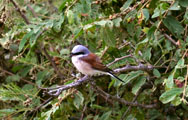

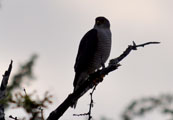
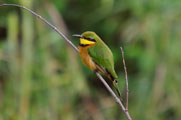
Just a few of them ......
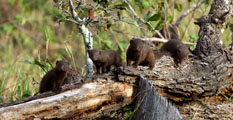
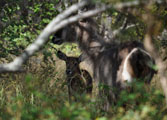
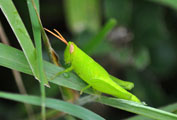
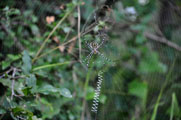
... and a few more .....
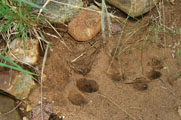
... and one last great track of a lion .....
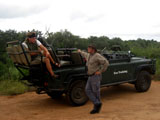
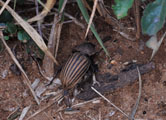
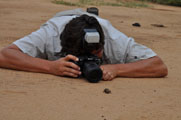
One last macro session with a special beetle .....
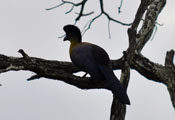
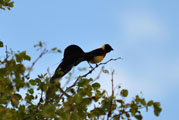
... some very special birds .......
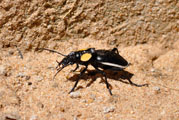

... and we are back on camp just on time for breakfast.
The afternoon drive, our last one for this camp, brings us to Sunday Rock for sun downers.
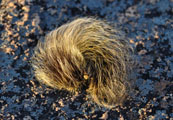
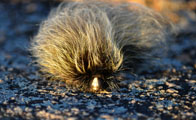
This great caterpillar fascinates us .....
After dinner Albie offers one last night drive.
Sure we want to come!
We spot a Bush Baby that is very patient and also performs by jumping between two trees .... quite a jump for such a small creature .... and then on the Boulevard, the "main track"
in the reserve, suddenly we see the two Lions lying along the side of the track ... very relaxed .....
The guy in the spotter-seat gets a bit nervous as the Lions get up ... but they just trot away into the bush .... one last good-bye from the animals to us!
What a course, what a guide, how lucky have we been!
Thanks to all of you who have made these two weeks something we will never forget!
Thanks to Andreas, Christian and Albie for the photos.
With Albie we had the chance to get one of the best guides one can find.
His knowledge and passion is just phenomenal.
Thanks a lot!
So on Friday morning it is time to say good-bye and head out into the unknown Africa that awaits us.
We head to Hoedspruit in search of an Internet Cafe to see what our account is making .... reality is calling.
We check into the caravan park at the Hoedspruit Wilderness Resort and what do we see .....??????
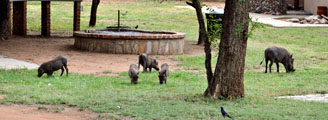
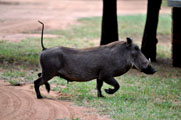
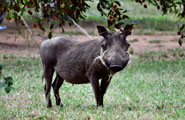
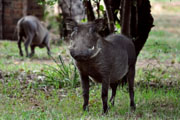
Warthogs!!!!!!!!!!!
| 
![]() Created by Level X Webdesign
Created by Level X Webdesign